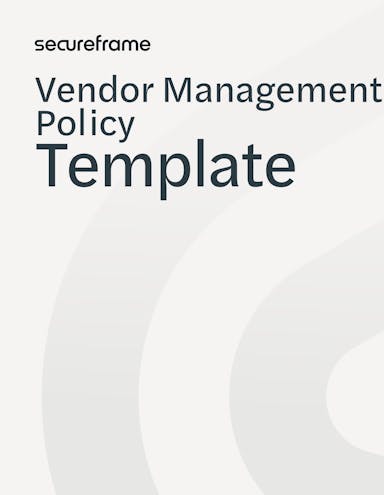
How To Create a Vendor Management Policy + Template
Emily Bonnie
Senior Content Marketing Manager
Fortuna Gyeltsen
Senior Manager, Compliance and Product (Automation)
A vendor management policy (VMP) is a way for companies to identify and prioritize vendors that pose a risk to their business. The policy identifies potentially risky vendors and prescribes controls to minimize risk and ensure compliance with popular frameworks like SOC 2, ISO 27001, and NIST CSF.
Vendor management policies are a critical component of an organization’s overall compliance risk management strategy.
A vendor management policy (VMP) isn’t just a compliance checkbox; it’s your blueprint for protecting your organization’s data, operations, and reputation from third-party risk. As supply-chain attacks rise and regulators tighten oversight, having a clear, enforceable VMP is essential for maintaining business continuity and customer trust.
Ready to find out how a vendor management policy can safeguard your organization against vendor risk? We break down how to create one and offer a template to get you started below.
Why you need a vendor risk management policy
While organizations tend to have a clear picture of the internal security risks their business faces, the risks that come from vendor outsourcing can be a bit murkier.
Regulatory bodies have begun to step in and implement stricter protocols regarding vendor oversight and third-party risk management. A Venminder report found that 69% of organizations feel they’ve been getting more scrutiny over the last 12 months by regulators and auditors.
The more vendors you work with and share sensitive information with, the more exposed your organization is to vulnerabilities. Gartner’s 2025 Cyber Risk Management Survey found that 60% of organizations experienced at least one vendor-related incident in the past year. And when a third party is involved, data breaches tend to cost more. IBM's Cost of a Data Breach report found that the cost of a third-party data breach increases by almost $400,000, for an adjusted average total cost of $4.88 million.

As digital ecosystems expand, vendor risk extends beyond traditional service providers to include cloud platforms, AI tools, and open-source software dependencies. Regulators and auditors increasingly expect organizations to demonstrate real-time monitoring and automated controls rather than relying on annual reviews alone.
Recommended reading

99+ Essential Third-Party Risk Statistics and Trends
How to create a vendor management policy
To begin creating a vendor management policy, you must first put together a team to spearhead the information security policy creation process.
This should be a comprehensive team that brings together different stakeholder viewpoints from across the organization.
Here are team members to consider including:
- IT department team member
- A legal representative
- Member of senior management
- Team members that communicate with vendors on a daily basis
- Subject matter experts
- Someone representing the business unit
- Internal auditors
Once you’ve assembled your vendor management policy team, assign roles and responsibilities to own different sections of the process.
Next, gather your list of vendors. This should be an in-depth list containing all third-party vendors, service providers, contractors, partners, and associates that you work with.

Pay special attention to those vendors that:
- Have access to sensitive data or Personally Identifiable Information (PII)
- Have access to your internal network
- Your organization relies on them to perform critical business functions
The vendors that meet any of the above criteria should be considered critical vendors because of the level of information they can access.
This master list will serve as a blueprint to help you prioritize vendors based on the risk they pose.
Recommended reading

Secure Vendor Onboarding: Best Practices to Reduce Third-Party Risk [+Checklist]
What should a vendor management policy include?
There’s no one-size-fits-all approach for creating a vendor management policy.
Each organization comes with its own unique set of vendors and information to protect.
Whether you’re creating a vendor management policy for the first time or looking to strengthen your current policy, here are a few sections that will help build a solid foundation for managing vendor relationships.
Purpose
The purpose section of your VMP is an overview of what the policy will entail. You can think of this as a thesis statement introducing the many sections that will follow.
Here’s an example of what a purpose statement could look like:
- (COMPANY) utilizes third-party products and services to support our mission and goals. This Vendor Management Policy contains the requirements for how (COMPANY) will preserve and protect information when using third-party products and services.
Audience and scope
The audience and scope sections will define whom exactly the policy applies to. This is where the careful consideration in creating the master list of vendors comes in handy.
Doing your due diligence in identifying your vendors helps ensure that none fall through the cracks and that you are able to appropriately monitor and track every vendor that poses a risk.
A few vendor areas to consider including in your vendor management policy are:
- Human resources security
- Physical and environmental security
- Network and system security
- Data security
- Access control
- IT acquisition and maintenance
- Fourth-party vendors
- Incident management
- Business continuity/disaster recovery
- Regulatory compliance and security standards
Roles and responsibilities
Each person that plays a significant role in your vendor management process should be included within the VMP. Include their specific responsibilities as it relates to vendor management.
Outline each role within your organization that handles key vendor management duties, such as a vendor manager. List the specific responsibilities under each role within this section.
Some key aspects to include are:
- The role (or roles) responsible for enforcing the vendor management policy
- The role (or roles) responsible for reviewing and updating the policy
Definitions
List and define some of the common terms used within the policy. This is an opportunity to establish common terminology that will be easily understood by anyone who may need to review your vendor management policy.
For example, you may want to clearly define what a vendor is or the type of data you’ll be referring to within the document.
However, remember that your vendor management policy should be a high-level document that’s meant to outline in basic but broad terms how the organization will conduct third-party management.
Assessments
The assessments section should include all of the ways vendors will be vetted before becoming fully operational.
While this section will look different for each company, many organizations include information about:
- Non-disclosure agreements or business associate agreements
- When vendors may have access to data (such as after the NDA is signed or following a risk assessment)
- What to do if high-risk findings are identified in risk assessments
- The frequency with which vendor risk assessments will occur
- Any regulations such as PCI DSS or HIPAA that a vendor must comply with
Management processes
This section will explain the management processes the organization will follow to ensure vendors are assessed and held accountable.
Within this section, be sure to specify what vendor agreements and vendor contracts must include.
For example, you may want to include verbiage about minimum information security requirements, instructions for the destruction or disposal of the organization’s information, and incident response requirements.
This section should also detail the vendor lifecycle management process. Include information for onboarding a new vendor as well as managing and offboarding current vendors.
Enforcement
After stating all vendor requirements, you must also include a section of how the policy is going to be enforced.
This section should clearly state the consequences a vendor will face if they fail to follow the policy. This may include termination of contract, removal of access rights, or related civil or criminal penalties.
How to assess new vendors
Before signing a contract with a potential new vendor, organizations can rate vendors against vendor management security controls to determine a security rating.
That rating can be used to determine if the organization should work with the vendor. It can also serve as a benchmark for security performance evaluations over time.
Recommended reading

The Ultimate Guide To Effective Vendor Risk Assessments: 47 Questions to Ask to Protect Your Business
Vendor management policy best practices

Vendor management policies will differ from organization to organization. However, here are a few important tips to keep in mind as you create or improve your vendor management policy:
- Have a plan in place for vendor service failures: Be proactive by documenting what areas of the business would be affected in the event of a vendor service failure. Create an internal response plan for each vendor and assign specific roles to your vendor management team.
- Have a dedicated vendor manager: When creating your vendor management team, it can be helpful to assign a specific vendor manager for each of your IT vendors.
- Hold all vendors to the same standards: While vendors posing a critical risk often take up the majority of vendor management efforts, it’s important that all vendors are required to follow the same set of requirements and uphold the same expectations.
- Keep your policy short and sweet: A vendor management policy should serve as a broad overview of how you plan to tackle vendor management. Aim for 5-7 pages.
- Review your VMP annually to keep it current: Regulations, technologies, and vendor relationships evolve quickly. Review your vendor management policy at least annually or when new frameworks, technologies, or key vendors are introduced. Consider conducting tabletop exercises to test vendor incident response plans and update roles and responsibilities as your business grows.
- Cover the six pillars of vendor management in your policy: To ensure an airtight policy, you’ll want to include information on vendor selection and procurement, assessing risk, due diligence, contractual standards and service-level agreements (SLAs), reporting requirements for vendor compliance and non-compliance, and ongoing monitoring.
- Use automation to scale due diligence and monitoring: Platforms like Secureframe automate evidence collection, track vendor compliance across frameworks, and flag changes in security posture, saving time and reducing manual effort while improving visibility into vendor risk.

Vendor management policy template
Still unsure of what your vendor management policy should look like? We’ve created a template that you can use as a foundation for building your own.
How Secureframe can help you manage vendor risk
Continuous monitoring is a must for vendor management programs, but it can be a burdensome undertaking for your team.
Secureframe simplifies vendor management with automated evidence collection, real-time vendor monitoring, and AI-assisted questionnaire validation. Instead of manually chasing documentation, you get an up-to-date view of your vendors’ compliance posture, plus the peace of mind of knowing you’re always audit-ready.
Looking to safeguard your vendor relationships and better manage your cybersecurity? Schedule a demo with our team today to see how automation can support your needs.
Use trust to accelerate growth
FAQs
What is a vendor risk management policy?
A vendor risk management policy is a formal document that outlines how an organization evaluates, monitors, and mitigates risks associated with its third-party vendors. It establishes guidelines and procedures to ensure vendors meet the organization’s security, compliance, and operational requirements.
How to write a vendor management policy?
To write a vendor management policy, start by defining its purpose and scope. Identify the key risks and requirements for your organization, then outline processes for vendor selection, onboarding, risk assessment, ongoing monitoring, and termination. Include roles, responsibilities, and compliance standards. Ensure it aligns with relevant regulations and business objectives.
What is an example of vendor risk management?
An example of vendor risk management is conducting a risk assessment for a cloud service provider. This process might include evaluating the provider’s security reports (such as SOC 2 or ISO 27001), reviewing their incident response policies, and requiring a signed agreement to adhere to your organization’s security and compliance standards.
How do you create a vendor risk management program?
To create a vendor risk management program, start by defining its goals and identifying key risks. Develop a framework for vendor evaluation, onboarding, and ongoing monitoring. Incorporate risk assessments, due diligence processes, and compliance checks. Establish clear communication with vendors, maintain detailed records, and regularly review and update the program to address evolving risks and regulations.

Emily Bonnie
Senior Content Marketing Manager
Emily Bonnie is a seasoned digital marketing strategist with over ten years of experience creating content that attracts, engages, and converts for leading SaaS companies. At Secureframe, she helps demystify complex governance, risk, and compliance (GRC) topics, turning technical frameworks and regulations into accessible, actionable guidance. Her work aims to empower organizations of all sizes to strengthen their security posture, streamline compliance, and build lasting trust with customers.

Fortuna Gyeltsen
Senior Manager, Compliance and Product (Automation)
Fortuna Gyeltsen is a former auditor and security consultant with nearly fifteen years of experience in security, privacy, and compliance. As a consultant for Blue Canopy and Coalfire, she developed deep expertise in FISMA, ISO 27001, SOC 2, PCI DSS, BSI C5, and DoD IL 4 and 5. At Secureframe, she worked as a Senior Manager of Compliance and now of Product to help customers automate more of the compliance process so they can focus on big picture improvements rather than shallow work.